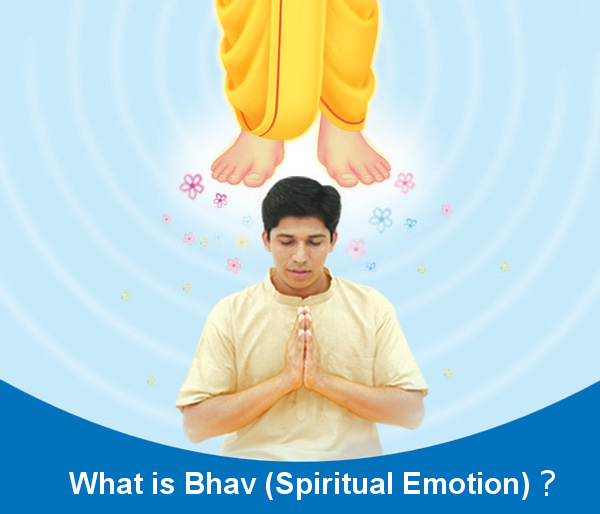According to Bhaktiyoga (Path of Devotion) a devotee should be able to reach a state wherein such intense love for God is generated that he should have an intense awareness that God exists. Thereafter, he has to develop an intense attraction for Him. This itself is known as bhav towards God. Without bhav it is not possible to develop Bhakti (Devotion).
1. Definition and meaning of ‘bhav’
While carrying out every action in our day-to-day life, we are always aware of our own existence, since it is deeply ingrained in us. All events occur or are experienced in relation to this awareness itself.
-
1 A. Bhav is replacement of the ‘I’ in one’s life by the awareness of the existence of God or the Guru with equal intensity.
-
1 B. An intense awareness about the existence of God or the Guru in any form, carrying out day-to-day life activities based on this feeling and experiencing life based on this background is referred to as bhav towards God or the Guru.
-
1 C. A Saint’s heart is soaked with the love of God, which He nurtures throughout His life. In such a heart resides unlimited intimacy towards God, and is known as bhav.
Importance : Saints say that if an individual wants to experience God’s touch, then the ultimate necessity is ‘bhav’.
2. The journey of a seeker in Bhaktiyoga
Belief – Expressed bhav – Faith – Devotion – Unexpressed bhav
On realising the importance of sadhana (Spiritual practice) intellectually, a belief develops towards sadhana and the person begins his sadhana. The journey of a seeker in Bhaktiyoga is mostly from Sagun (With-attributes) to Nirgun (Without-attributes). Such a seeker cannot develop bhav towards God unless he believes in some Sagun form of God. During the process of awakening of bhav, he generally moves ahead with the help of expressed bhav namely Ashṭasattvik bhav. One can have spiritual experiences only if there is bhav, and faith develops due to spiritual experiences. An emotionally inclined seeker first develops an expressed bhav at the psychological level, while in a seeker who is convinced intellectually, faith develops first. Thus, generally speaking, expressed bhav develops first, followed by faith; but this sequence can change depending upon the individual. When sadhana is faithfully performed under the guidance of a Guru, the devotion towards God gets enhanced on its own. During the stage of expressed bhav, his attraction towards Maya (The Great Illusion) gradually reduces. His state is like – mostly involved in contemplation on God despite being in the realm of Maya. This distance from Maya creates a state of detachment. Even in this state of detachment, he experiences God within the realm of Maya, which further enhances his faith in God. This state culminates into a state of profound devotion. Such pure devotion then teaches the seeker about unexpressed bhav. Expressed bhav is trigunatmak, while unexpressed bhav is trigunatit. With the help of unexpressed bhav only, can one approach Nirgun and formless God.
3. Difference between bhav and bhavana
Bhav is a state of the chitta (subconscious mind). Thus, bhav can be said to be a state of concentration of the subconscious mind generated by merger of the quality and the one possessing it. Bhavana (emotion) on the other hand, is the attitude of the mind. Desires and emotions are small and big waves arising in the mind.
Tears are an indicator of both bhavana and bhav. Shedding tears out of grief is bhavana, while a flow of tears upon remembering the Guru or God is bhav.
Reference : Sanatan Sanstha’s Holy Text, ‘Spiritual Practice for awakening Spiritual Emotion’


 Why do we chant Name of Kuladevi instead of Kuladev?
Why do we chant Name of Kuladevi instead of Kuladev? Remember this while performing the rites of cremation during calamitous times!
Remember this while performing the rites of cremation during calamitous times! Remedies for mental illness arising in an emergency
Remedies for mental illness arising in an emergency how to improve mental strength to face a terrible situation such as a riot
how to improve mental strength to face a terrible situation such as a riot Unique Spiritual experiences of Miss Smital Bhujle after chanting Om Namah Shivay
Unique Spiritual experiences of Miss Smital Bhujle after chanting Om Namah Shivay Do you know, Yogic postures and pranayam accompanied with chanting enhances its benefits!
Do you know, Yogic postures and pranayam accompanied with chanting enhances its benefits!